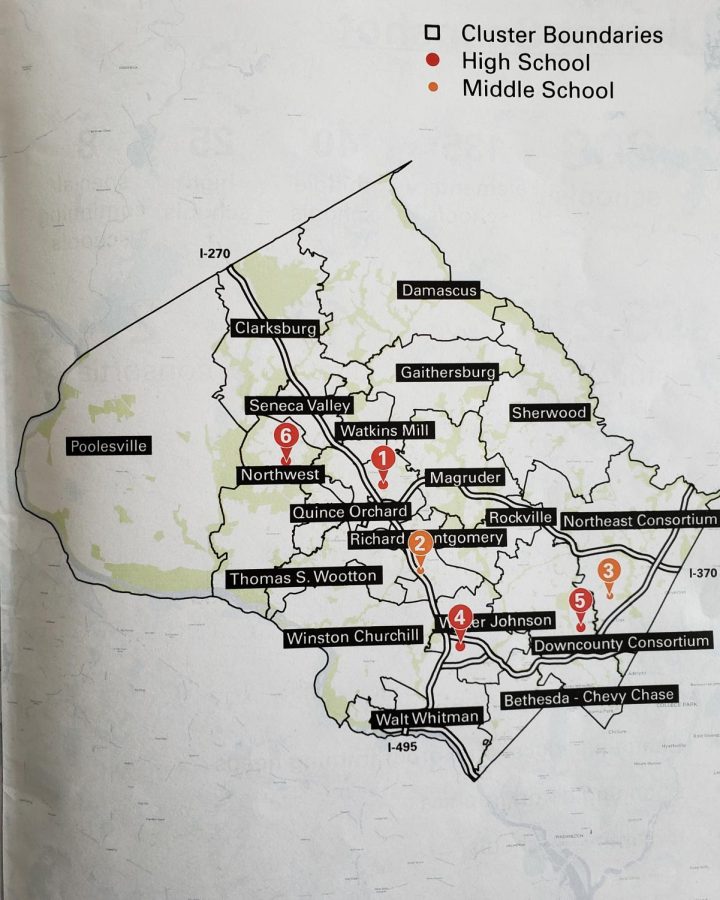MCPS Boundary Study Stirs Controversy
February 20, 2020

MCPS is Maryland’s largest school district
Montgomery County Public Schools, despite regularly being called one of the best public school systems in the nation, has a number of issues that have not only challenged its reputation but have challenged its very core values.
De facto school segregation, a growing achievement gap, countywide racist incidents, students not being assigned to the schools closest to them, empty classrooms, and overcrowding are some of the larger issues the district faces.
The District Wide Boundary Analysis, a study commissioned by the MCPS Board of Education (BOE), began in November of 2019 “to provide a comprehensive assessment of Montgomery County Public School boundaries by analyzing various data points such as school facility utilization and capacity, student demographics, school assignment, and travel patterns,” according to the BOE.
Almost immediately after the board announced their decision to launch the study, issues arose. Community members brought up a number of areas of concern including a misinformed belief that the board’s ultimate goal is to start “bussing” students across the county in order to force diversity. The board almost immediately looked to assuage those concerns and has made it clear that this study “will result in an analytical assessment and a summary of the community engagement process” and “will not make recommendations on potential boundary revisions.”
Currently, the study is entering its second of three phases. Phase 1 was geared towards information gathering, while phase 2 will focus on analyzing and communicating that knowledge to the public. So far, the board has gained some crucial information from this study not only in terms of data but also in terms of public reaction and sentiment.
One unanticipated result of the study has been the very public sharing of people’s thoughts on Montgomery County, the schools, and the community. To support the study, the BOE has held six Regional Public Meetings in schools throughout the county for students, parents, and community members. In these meetings, which have gotten contentious at times, there have been a lot of opinions about the study and an outpouring of support both for and against it and its ultimate findings.
The study was originally proposed by last year’s Student Member of the Board of Education (SMOB), Ananya Tadikonda, and has been championed by student activist groups including MoCo Students For Change, who have been very vocal in their support of the study in open meetings. Some of the students have openly discussed the issues they see at MCPS high schools in particular. According to Margaret Barthel of WAMU, the American University Raido, one student of color at Walt Whitman High School, Breanna McDonald, spoke at a town hall where she detailed her traumatic experience navigating the racial politics at her majority white school. McDonald claimed that more diversity would improve the school environment and help her and other students of color feel less isolated. McDonald’s experiences and beliefs were echoed by other students, who expressed how they’ve seen firsthand the economic discrepancies between schools and the effect that a lack of racial diversity can have on a school’s environment.
The current racial demographics of MCPS according to their Division of Capital Planning — 28% White, 31% Hispanic, 22% Black, 15% Asian, 5% other (mixed race, native, pacific islander)— show considerably more diversity than the county has had in the past. Less than 50 years ago, the student body was nearly 90% white. Many of the schools, however, do not reflect this increased diversity. The majority of the minority and low-income students are concentrated in North and East County schools like Gaithersburg, Paint Branch, Kennedy, Northwood, and Blake, while the higher-income, white students are concentrated at what are colloquially known as “the W Schools” in the west side of the county: Walt Whitman, Walter Johnson, Winston Churchill, and Thomas Wooton.
“For 50 years, the achievement gap in Montgomery County has grown in the shadows” wrote Superintendent Jack Smith in a May 3rd Washington Post Op-Ed. In his piece, Dr. Smith notes the disparity between Free And Reduced Meals (FARMS) students and their higher-income peers as well as between Hispanic and Black students and their White and Asian peers. He claims that, according to data from the Equity Accountability Model (an assessment tool that monitors and reports all students performance focusing on FARMS and minority groups) the main predictor of low performance is poverty.
Last year saw a series of countywide racist incidents at predominantly white schools that garnered media coverage and police investigations. In April, Whitman students posted an image of themselves in blackface and captioned it with a racial slur. This was the third racist incident to occur at a school that is 67% white and 5% black. At Churchill in 2016 students taped a “whites only sign” to a bathroom door, and that same month, multiple images of swastikas were found in a Bethesda middle school. Dr. Smith deemed this trend of racial vandalism following the 2016 election “disturbing,” “unacceptable,” and “simply wrong.”
Diversity, both racial and economic, are just one of the three focuses of the Districtwide Boundary Analysis. Proximity and utilization are also important factors the board is assessing.
According to a report by WXY, the architecture firm contracted to complete the analysis, 43% of students currently aren’t assigned to the school closest to them. This, according to the report, puts a strain on district resources and burdens families for whom transportation is an issue.
In this same report, facility utilization is described as the number of students divided by available seats. Schools are ideally supposed to fall within the 80% to 100% range, but out of the 200 elementary, middle, and high schools, only 80 fall within this range, and the rest are either over or under utilized. The report also notes that “schools with very different utilization rates are often adjacent and within the same cluster” meaning there are overcrowded schools next to schools with empty seats.
It’s been five decades since Montgomery County’s last major boundary study according to Pat O’Neil, a longtime Board of Education member, although there have been redistricting efforts since then.
The Regional Public Meetings were designed to engage members of the community through discussions and polls, but the events have sometimes devolved into shouting matches with comments expressing skepticism about the effectiveness of the study. “Can we please hold off until we get data from other localities that show that this is a valid approach?” said one impassioned attendee at the Northwest High School community meeting in January. Other criticisms seem to stem from a fear of having community torn apart or property values decrease. “If you value maintaining a sense of community,” said parent Rami Kandel at a November community meeting in Rockville, “any significant redistricting would dramatically and negatively impact the sense of community across the entire county.”
The issue of property values was a hot-button topic for a number of people at the town hall meetings. For many homebuyers, when choosing where to live, the school district and the school a home is zoned for are among the top criteria that parents or future parents consider. In the event of redistricting, a home’s value could drop if it is rezoned into a lower-performing or lower-ranked school. On an online forum, one parent, who claimed to be a real estate broker, said in response to this study that “any attempt to pull out the rug from under these homeowners is simply theft.” Regarding this issue, in a letter to community members, Dr. Smith and BOE President Shebra Evans wrote: “while we understand that individuals may have many interests—from property values to traffic management—the school system is committed to its mission, providing all students with access and opportunity to a high-quality education.”
While they will be keeping the varied interests of the parents and community members in mind– understanding their concerns are an important part of this study– the BOE’s main focus is the students and ensuring that they get the best possible education. Whether this is through better resource allocation, changing school boundaries, or something entirely different is yet to be determined. The county has reiterated that, right now at least, no immediate action is to be taken as a result of this analysis, and the final report which will summarize the findings of the analysis is expected this June.
MCPS Boundary Study Link: https://www.montgomeryschoolsmd.org/departments/publicinfo/boundary-analysis/study-videos.aspx












































